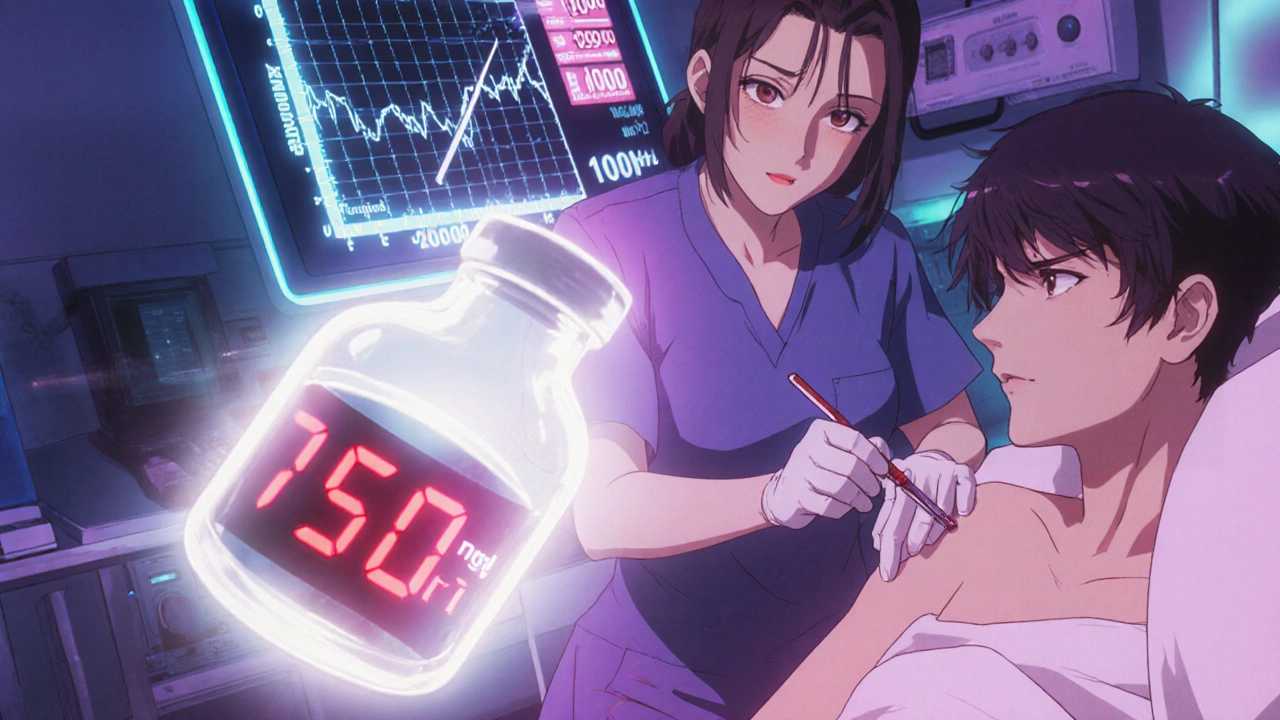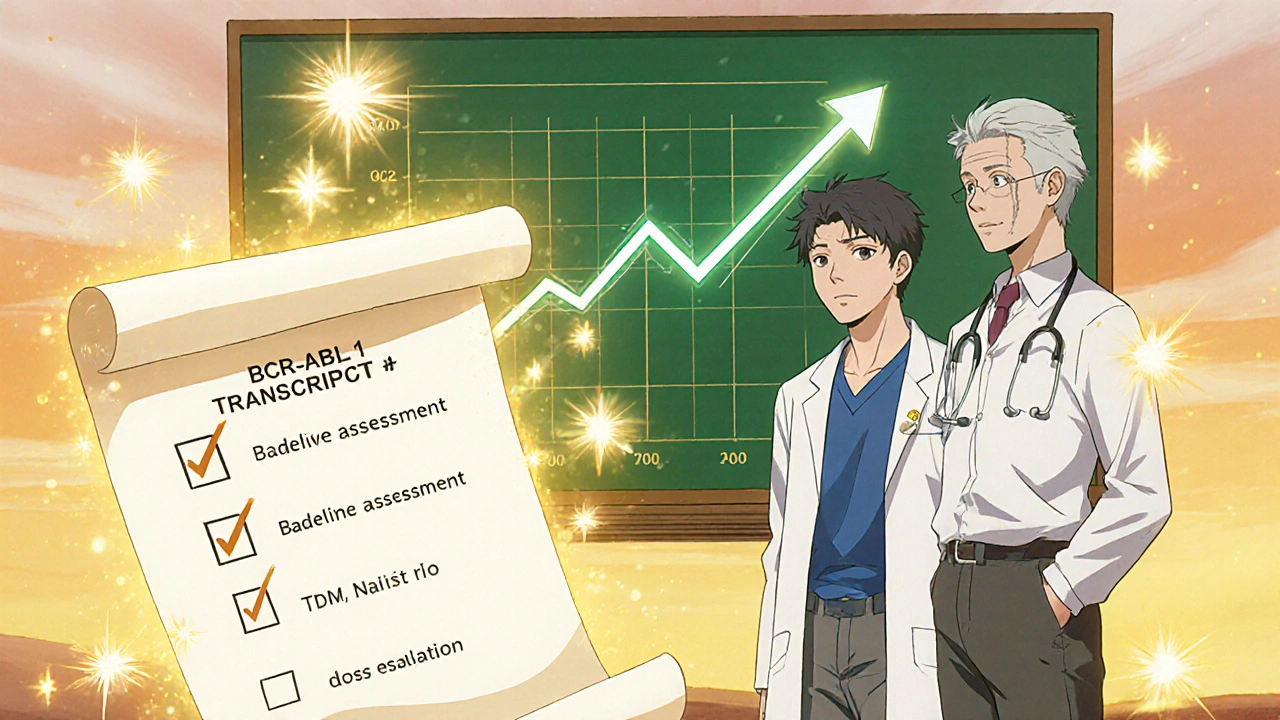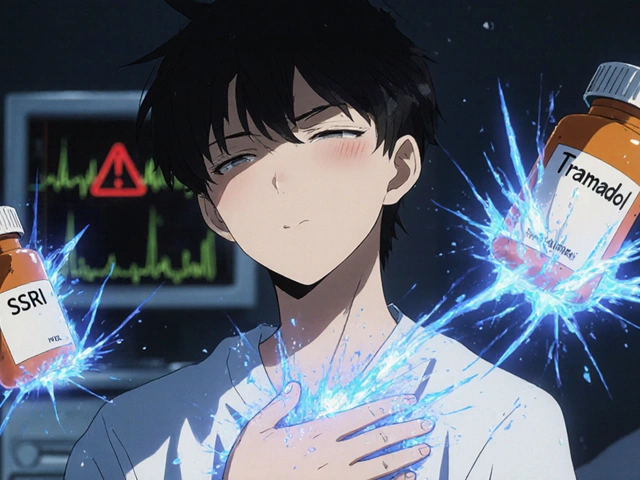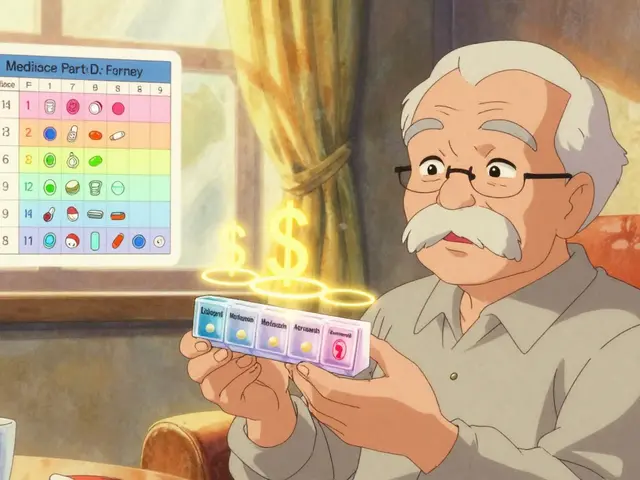Imatinib Dose Optimization Calculator
Therapeutic Range Calculator
This tool helps determine if your Imatinib trough level is within the optimal therapeutic range (1000-2000 ng/mL) and provides guidance for dose adjustment.
How to use this tool:
- Enter your most recent trough level from TDM test
- Click "Calculate Optimization" to see results
- Review recommendations and discuss with your physician
When doctors prescribe Imatinib is a tyrosine‑kinase inhibitor that targets the BCR‑ABL1 fusion protein, the cornerstone of modern chronic myeloid leukemia (CML) therapy. Yet many patients still experience sub‑optimal responses because the dose isn’t fine‑tuned to their individual biology. This article walks you through why dose optimization matters, how to monitor it, and practical steps to get the best possible outcome.
Why dose matters for Imatinib
Imatinib’s efficacy hinges on maintaining a therapeutic plasma concentration that consistently suppresses BCR‑ABL1 activity. Studies published in 2023 showed that patients with trough levels below 1000 ng/mL had a 30 % lower chance of achieving a major molecular response (MMR) within the first year.
Two key factors drive variability:
- Genetic differences in drug metabolism (CYP3A4 polymorphisms)
- Patient‑specific factors such as body weight, kidney function, and adherence
Because of this, a one‑size‑fits‑all 400 mg daily regimen can leave a sizeable subgroup under‑dosed.
Therapeutic drug monitoring: the science behind it
Therapeutic drug monitoring (TDM) for Imatinib is a structured Therapeutic drug monitoring is a clinical practice that measures drug concentrations in blood to adjust dosing for optimal efficacy and safety. It involves drawing a trough sample (just before the next dose) and comparing the result to a target range of 1000-2000 ng/mL.
Key metrics:
- Plasma concentration: measured in nanograms per milliliter; directly correlates with BCR‑ABL1 inhibition.
- Peak‑to‑trough ratio: helps identify erratic absorption or missed doses.
When the trough falls below the lower bound, clinicians usually consider dose escalation, adherence counseling, or addressing drug‑food interactions.
Practical steps to optimize dose
- Baseline assessment - record weight, renal function (creatinine clearance), and CYP3A4‑modulating comedications.
- Initiate TDM after two weeks of steady dosing; obtain a trough sample.
- If trough < 1000 ng/mL, evaluate adherence first. Use pill counts or electronic caps.
- Adherence Adherence is the degree to which a patient follows prescribed dosing schedules. below 90 % warrants counseling before dose changes.
- When adherence is confirmed, increase the daily dose by 100-200 mg increments every 2-4 weeks, re‑checking trough levels each time.
- Monitor for toxicity - grade 2-3 edema, nausea, or liver enzyme elevations may signal the need to pause escalation.
- Document the final maintenance dose that consistently yields troughs within 1000-2000 ng/mL.
Typical dose range: 400 mg → 600 mg → 800 mg daily. Some refractory patients even benefit from 1000 mg, but safety data become sparse above 800 mg.

Case study: dose escalation improves outcomes
John, a 58‑year‑old with chronic phase CML, started on 400 mg Imatinib. After three months his BCR‑ABL1 transcript level was 12 % (not yet a complete cytogenetic response). TDM revealed a trough of 750 ng/mL.
After confirming 95 % adherence, his physician escalated to 600 mg. Two months later the trough rose to 1350 ng/mL and the transcript dropped to 2 % - a major molecular response.
At 12 months, John remained in deep molecular remission, illustrating how a modest dose change can convert a partial responder into a long‑term survivor.
Common pitfalls and how to avoid them
Resistance mutations Resistance mutation is a genetic alteration in the BCR‑ABL1 kinase domain that reduces drug binding effectiveness. can masquerade as low plasma levels. Before escalating, test for the T315I or other kinase‑domain mutations via PCR.
Other errors:
- Skipping TDM after dose changes - you won’t know if the new dose achieved the target.
- Ignoring food interactions - proton‑pump inhibitors can lower Imatinib absorption by up to 30 %.
- Over‑escalating without toxicity monitoring - high doses may trigger severe myelosuppression.

Checklist for clinicians
- Record baseline weight, renal function, and CYP3A4‑affecting drugs.
- Schedule first trough sample after 2 weeks of 400 mg daily.
- Verify adherence >90 % before any dose increase.
- Escalate by 100-200 mg increments; repeat TDM every 2 weeks during titration.
- Watch for grade ≥ 2 edema, nausea, or ALT/AST rise.
- Test for BCR‑ABL1 resistance mutations if molecular response stalls despite optimal troughs.
- Document final maintenance dose and target trough range (1000-2000 ng/mL).
Comparison of standard vs optimized dosing outcomes
| Metric | Standard 400 mg | Optimized (400‑800 mg) |
|---|---|---|
| Median trough (ng/mL) | 820 | 1,380 |
| Major molecular response at 12 mo | 58 % | 78 % |
| Progression‑free survival (5 yr) | 82 % | 91 % |
| Grade ≥ 3 toxicity | 7 % | 10 % |
Next steps for patients and providers
Patients should ask their oncologist about TDM and whether their current dose keeps trough levels in the therapeutic window. Providers can start a formal dose‑optimization protocol in their clinic, using the checklist above as a backbone.
When both parties work together, the odds of achieving a deep, durable response rise dramatically - turning a life‑threatening disease into a manageable chronic condition.
What is the target trough level for Imatinib?
Current guidelines recommend a trough between 1000 and 2000 ng/mL. Levels below 1000 ng/mL are linked to lower major molecular response rates, while levels above 2000 ng/mL can increase toxicity without added efficacy.
How often should therapeutic drug monitoring be performed?
Initially, obtain a trough after two weeks of steady dosing. If the dose is changed, repeat the test after another two weeks. Once a stable therapeutic range is achieved, annual checks are usually sufficient unless clinical status changes.
Can I increase my Imatinib dose on my own?
No. Dose changes should only be made under medical supervision after reviewing trough levels, adherence, and potential side‑effects. Unsupervised escalation can raise the risk of severe edema, liver toxicity, or hematologic problems.
What foods interfere with Imatinib absorption?
Proton‑pump inhibitors (e.g., omeprazole) and antacids can reduce absorption by up to 30 %. Taking Imatinib with a light meal or at least 30 minutes before a high‑acid food helps maintain consistent levels.
What should I do if I experience side‑effects after dose escalation?
Report symptoms promptly. Mild edema or nausea can often be managed with dose‑timing adjustments or supportive meds. For grade ≥ 3 toxicity, the physician may pause escalation, reduce the dose, or switch to a second‑generation TKI.







John Price
October 21, 2025 AT 12:36Solid point, dose matters.
Casey Cloud
November 13, 2025 AT 15:10First off the whole dose‑tuning thing is not just a fancy idea it actually changes outcomes for a lot of CML patients. The key is to get that trough level into the 1000‑2000 ng/mL window and keep it there. You start with a baseline weight and kidney function then draw a trough after two weeks on 400 mg. If the number is below 1000 you double‑check adherence before you even think about adding more pills. Pill counts or smart caps can tell you if the patient is missing doses. Once you’re sure they’re taking it, bump the dose by 100‑200 mg and repeat the TDM in another two weeks. Keep doing that until the trough sits comfortably in the target range. Watch for edema, nausea or liver enzymes climbing – those are the red flags that say you’ve gone too far. If you hit a mutation like T315I you need a different TKI, not just more imatinib. Food interactions matter too – PPIs can knock absorption down by a third so timing with meals is crucial. The data from 2022‑2024 shows a jump from 58 % to 78 % major molecular response when you optimize dosing. That’s a huge win for patients who might otherwise linger in a partial response. The downside is a slight rise in grade ≥ 3 toxicity from 7 % to 10 % but it’s manageable with proper monitoring. Long‑term progression‑free survival also improves, hitting 91 % at five years with optimized dosing. So the bottom line is that systematic TDM and incremental dose escalation can turn a mediocre response into a deep remission. Don’t skip any step and keep the communication open with the patient for the best results.
eric smith
December 6, 2025 AT 18:43Oh sure, just crank up the pills like it’s a video game – because who needs nuance when you can just throw more medicine at the problem?
parbat parbatzapada
December 18, 2025 AT 08:30Yo the pharma giants don’t want us to know this but the real reason they push 400 mg is they’re scared of the truth that higher doses actually keep the disease at bay… they hide the data in big boring tables and then tell us to trust the “guidelines” lol. I’m telling you the secret labs have been measuring troughs for years and the only thing stopping people is the fear of side effects that they overhype. People think it’s just a pill but it’s really a power move against the hidden agenda. Trust no one, double check the numbers yourself, and don’t let the doctors play puppet master with your dose.